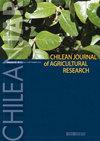咖啡幼苗施铁方式的比较
IF 1.5
4区 农林科学
Q2 AGRICULTURE, MULTIDISCIPLINARY
引用次数: 0
摘要
铁(Fe)被证明在某些特定功能中非常重要,没有它,植物可能会经历营养失衡,从而影响其发育。本研究旨在通过叶面施肥、基质预先施肥和基质水溶液施肥对咖啡(Coffea arabica L.)本文章由计算机程序翻译,如有差异,请以英文原文为准。
Comparison of iron application ways in coffee seedlings
Iron (Fe) is shown to be of great importance in some specific functions, and without it, the plant can experience a nutritional imbalance, thus affecting its development. The present study aimed to evaluate the effects of the application of Fe doses in coffee (Coffea arabica L.) âObatã IAC 1669-20â seedlings via foliar, previous fertilization of the substrate, and aqueous solution on the substrate and identify the best management. The experiment was carried out in a completely randomized design, with seven treatments and five replicates. The treatments were five Fe concentrations via foliar (0.30, 0.45, 0.60, 0.75, and 0.90 g of Fe L-1), previous fertilization on the substrate (0.372 g Fe m-3), and aqueous solution on the substrate (0.30 g Fe L-1), totaling seven treatments. Fertilization with Fe via foliar at 0.45 g Fe L-1 in the production of coffee seedlings showed significant influence on seedling height, stem diameter, and leaf area, in addition to having one of the highest values of Dickson quality index. Thus, coffee seedlings with the application of 0.45 g Fe L-1 via foliar had the best results, with 11.2 cm height, 4.1 mm diameter, 17.3 cm2 leaf area, and 0.32 Dickson quality index. It promoted seedlings with more significant gains in the foliar area (24.2%) and stem diameter (27.4%), allowing a shorter time in nursery. The treatment aqueous solution 0.30 g Fe L-1 on the substrate is a second option for the Fe application in coffee âObatã IAC 1669-20â seedlings. The treatment with the previous fertilization of the substrate with 0.372 g Fe m-3 is the less recommended.
求助全文
通过发布文献求助,成功后即可免费获取论文全文。
去求助
来源期刊

Chilean Journal of Agricultural Research
AGRICULTURE, MULTIDISCIPLINARY-AGRONOMY
CiteScore
3.10
自引率
11.80%
发文量
60
审稿时长
6-12 weeks
期刊介绍:
ChileanJAR publishes original Research Articles, Scientific Notes and Reviews of agriculture, multidisciplinary and agronomy: plant production, plant protection, genetic resources and biotechnology, water management, soil sciences, environment, agricultural economics, and animal production (focused in ruminant feeding). The editorial process is a double-blind peer reviewing, Editorial Office checks format, composition, and completeness, which is a requirement to continue the editorial process. Editorial Committee and Reviewers evaluate relevance and scientific merit of manuscript.
 求助内容:
求助内容: 应助结果提醒方式:
应助结果提醒方式:


